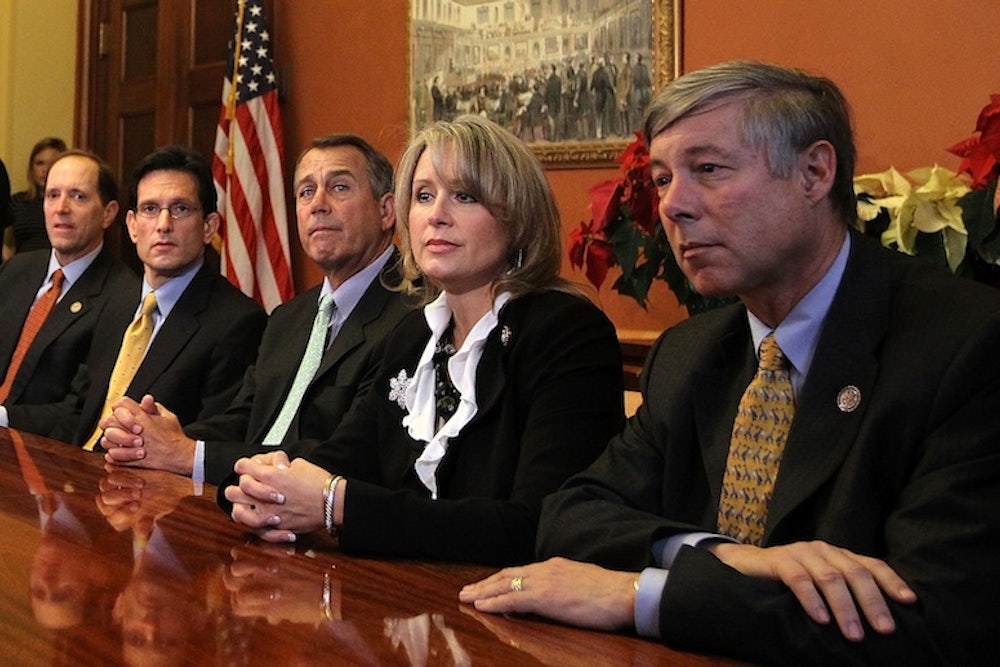House Republicans just put out a new report on the Affordable Care Act. You should take is as seriously as you take all reports from House Republicans these days.
In other words, you shouldn't take it seriously.
The subject of the report is enrollment in private health insurance through Obamacare. The Administration has reported that more than 8 million people have signed up for such plans, usually by using healthcare.gov or one of the similar online marketplaces that several states are running. Charles Gaba, the Michigan-based blogger and unofficial enrollment tracker, says the number is now up to 8.14 million. But not everybody who picks a plan actually pays the premium, which means that not everybody in that 8.14 million actually has insurance.
It's a relevant fact. But, to some Obamacare critics, it's become an obsession—proof, they say, that the law isn't reaching its goals. Wednesday's report, from Republican staff on the House Energy and Commerce Committee, would seem to validate that claim. According to the report, just 67 percent of people have paid their first month premiums. If that holds true for all signups, that would mean only about 5.45 million people really have insurance—less than even more pessimistic projections, although still a significant number by any reasonable standard.
But wait! With House Republican committee reports, you always have to read the details. And in this case the details say quite a lot. The committee staff got their information directly from insurers, but it’s only valid up through April 15. As experts quickly pointed out, that’s too early to get an accurate sense of the payup rate.
Remember, open enrollment officially ended on March 31. And, thanks to the Administration’s extensions, people were still signing up well into April. At the time the Committee requested the information, many of these people would have just received their first invoices for payment. Payment wouldn’t have been due until the end of the month—in other words, Wednesday. Some wouldn't owe first payments until the first of June, because that's when their insurance starts.
In other words, it’s safe to assume that the real payup rate is higher than 67 percent. How much higher? There’s no way to be sure. But there are plenty of encouraging signs. On Tuesday, at a breakfast sponsored by Politico Pro, the head of the insurance industry’s main trade group—Karen Ignani, of America’s Health Insurance Plans—said that about 85 percent of people who bought coverage through the marketplaces were paying premiums.
On the very same day, officials from Wellpoint told investors on a conference call that the payup figure was 90 percent, according to reports from the Washington Post’s Jason Millman and the National Journal's Clara Ritger. Those figures are consistent with what industry and government officials had said previously—most recently, earlier in April, when California officials said the payup rate in their marketplace was about 85 percent. (The House Republican report doesn't include data from state-based marketplaces, possibly skewing the numbers more.) That would put the actual number of people getting insurance somewhere around 7 million, give or take a few hundred thousand—which is what the Congressional Budget Office originally projected and actually a bit higher what the CBO projected a few months ago, after Obamacare's initial troubles.
One more reason to be skeptical about the report is its heft—or lack thereof. It is just one online page, with a link to a one-page table. It doesn't include the actual filings from insurers—perhaps because those filings, which the Committee's Democratic staff subsequently publicized, warned explicitly that the April 15 data was incomplete. "Data being provided in this submission ... does not represent final verified numbers," Humana officials said.
Compare that to one of the enrollment reports that the Department of Health and Human Services published throughout the open enrollment period. HHS hasn't always been a model of transparency, as anybody listening to its cringe-inducing conference calls during the fall and winter could attest. But those reports always had extensive data breakdowns, including raw data as well as averages. And the HHS reports came out every month, even when the news made the administration and its law look awful.
There's no way to know for sure if the Republican report is wrong. But, at this point, there’s also no reason to believe it’s right. HHS is due to produce its final enrollment report any day now. This certainly wouldn't be the first time a House Republican committee pushed out negative, but wildly misleading, information for the sake of timely propoganda.
The tactic works, no matter how many times fact-checkers and media point out the distortions. Once information like this is out there, it becomes a permanent part of the conversation. Republicans and their supporters will keep citing it, over and over again. Some will even say it’s proof that Obama is "cooking the books"—even if it turns out that it's Republicans, not the White House, playing games with the numbers.
Note: I added information about the insurance company letters to the Committee. Also, I originally referred to the information about timing as "fine print." It's actually right there, at the opening of the report, so I've changed that reference. Thanks to twitter follower Sarah Hurtubise for pointing out my error.
